
La faccia di Kenparker in copertina è impagabile :D
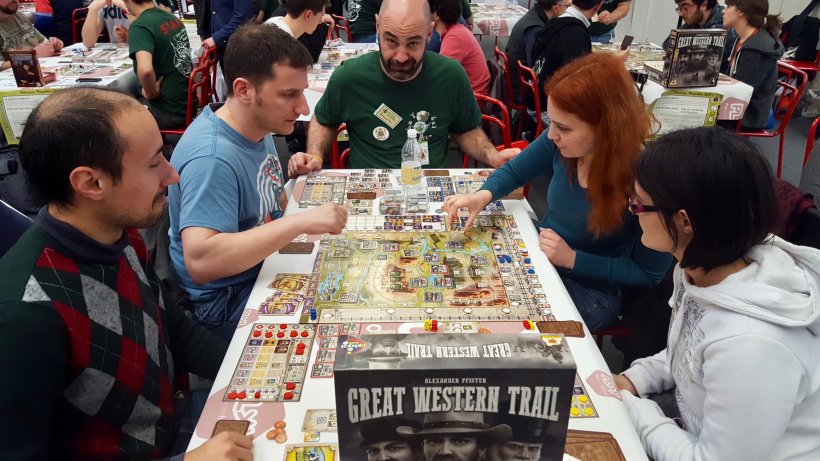
Per le interviste dedicate al premio Goblin Magnifico 2017, continuiamo con quella realizzata con Alexander Pfister, autore di Great Western Trail.
1) Facci sapere qualcosa di te: che tipo di giocatore sei? Parlaci dei tuoi giochi preferiti (non realizzati da te).
Ho 45 anni, sposato con una figlia, vivo a Vienna. I miei giochi preferiti sono: Concordia, Orleans, Sulle Tracce di Marco Polo. In definitive mi piacciono giochi strategici, con tante decisioni da prendere in tempi ristretti.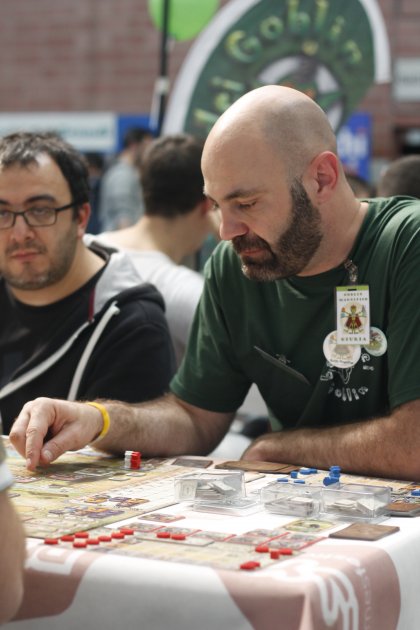
2) Dalla prova sul campo sembra che sia difficile ottenere cospicui vantaggi dalle tasse di passaggio sugli edifici, è un aspetto del gioco che appare secondario. Sei soddisfatto del livello di interazione presente nel gioco?
Le tasse di passaggio si pagano sugli edifici avversari. L’aspetto strategico sta nel costruire questi edifici sui sentieri dove presumibilmente passeranno i giocatori, paralleli ai passaggi con molte tessere pericolo.
Sono soddisfatto del livello di interazione presente: è importante poter pianificare in anticipo i turni per velocizzare il gioco. D’altro canto c’è tanta interazione sui treni e sul mercato delle occupazioni.
3) L’aspetto più originale del gioco è il viaggio ciclico. Un ciclo che non può mai ripetersi identico per il fiorire di nuovi edifici e di ostacoli ad ogni turno. Come hai sviluppato questa idea?
È stato il punto di inizio per lo sviluppo del gioco: volevo realizzare qualcosa come una rondella dinamica, ma con un tema più attinente (Nota del traduttore: si riferisce alla rondella di Gerdts). Sono stato contento di trovare un tema appropriato che fa quadrare tutto.
4) Treni, edifici, mandriani. Tre differenti strategie o tre componenti di un’unica strategia? È possibile vincere in The Great Western Trail concentrandosi su un unico aspetto? Ce n'è uno che non può essere trascurato?
Si può vincere con i treni, se si possiedono tanti ingegneri e stazioni. Bisogna raggiungere la fine del percorso. E bisogna possedere edifici che danno movimenti aggiuntivi al treno. Anche la strategia dei mandriani funziona bene. È facile e divertente da applicare. Molti principianti partono da questa. Anche in questo caso è importante avere degli edifici di supporto. La terza strategia, quella degli edifici, funziona più da supporto per le altre, anche se ho visto vincere costruendo edifici di alto livello nella fase iniziale della partita. Prova a guardare gli edifici di livello 9: sono veramente forti.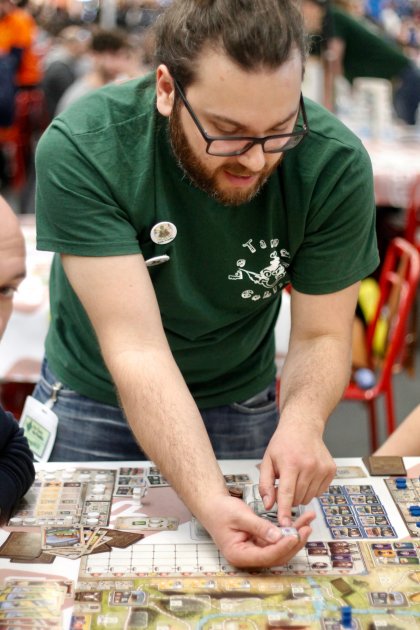
5) Nella nostra comunità molti giocano con la strategia più ovvia: mandriani e mucche, tanti di entrambi, e veloci viaggi a Kansas City. In questo modo il gioco si velocizza troppo, sembra impossibile poter costruire e ottenere un concreto vantaggio dagli edifici. Puoi suggerirci quale è il miglior utilizzo degli edifici?
Gli edifici sono un supporto alle altre strategie. Solo con gli edifici non si riesce ad impostare una strategia. Se due giocatori si lanciano sui mandriani ne prenderanno 1 o 2 a testa. Alla fine dipende dagli edifici in gioco: alcuni vanno meglio con la strategia dei mandriani, altri con la strategia degli ingegneri.
6) Parliamo un po’ del tema del gioco. Lo hai sviluppato assieme alle meccaniche? Sei partito dal tema o dalle meccaniche?
Sono partito dalle meccaniche, ma il tema è arrivato subito dopo. Anche se inizialmente non trattava della Great Western Trail, ma del petrolio e dell’oro nell’America del diciannovesimo secolo.
7) Quale pensi sia il numero ottimale di giocatori? Il tabellone è sempre lo stesso, quindi può essere assai diverso giocare in due o in quattro.
Il tabellone è lo stesso, ma anche in quattro ci sono spazi a sufficienza per le costruzioni. Quindi non penso ci siano grosse differenze tra giocare in due, tre o quattro. Non sono sicuro ci sia un numero ottimale di giocatori.
8) Kickstarter, Legacy, applicazioni per SmartPhones. Tre cose che sembrano invadere e cambiare il mondo dei giochi da tavolo. Hai un parere positivo o negativo su ciascuno di essi?
Penso che alcuni di quelli che utilizzano le app potrebbero provare il gioco da tavolo, penso sia uno dei fattori che fa crescere questo settore industriale. Riguardo kickstarter: è un bene averlo. Inizialmente serviva a chi non trovava un editore. Oggi è anche uno strumento di vendita per grandi editori.
Per il legacy: adoro il concetto, ma trovo richieda troppo tempo. Per completare un gioco ti servono 10-20 partite, e sono tante. Non so se avrà un impatto negativo sugli utenti, visto che la gente ha poco tempo a disposizione.
9) Hai giocato gli altri sette selezionati del nostro premio? Cosa ne pensi?
Ho giocato Terraforming Mars, Scythe, Star Wars rebellion e li ho apprezzati tutti. Complimenti per la lista.
10) A quali nuovi giochi stai lavorando? Raccontaci un po’ dei progetti futuri.
Sto lavorando a delle espansioni per Oh My goods e Port Royal. Entrambi includeranno una mia meccanica di racconto. Realizzerò anche un gioco di carte con Dennis Rappel per lo Öster Spielemuseum in edizione limitata.
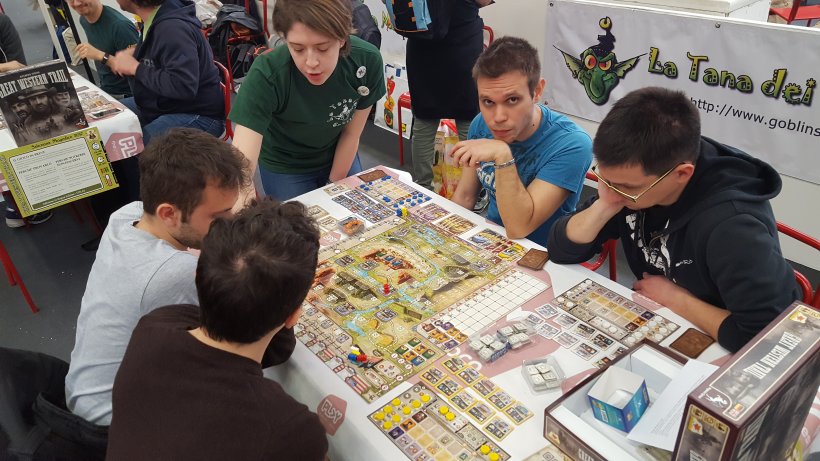
1) Tell us something about you: what kind of player are you? Tell us your favourite games (not made by you).
I'm 45 years old, married and have one daughter. I live in Vienna. My favorite games are Concordia, Orleans, Voyages of Marco Polo. So I like strategy games, which pack a lot of decisions in s short time.
2) Playing the game it seems really rare to gain something from the tolls of the buildings, and this aspect of the game seems really secondary. It's really rare having to stop on opponents' buildings, too. Are you satisfied by the interaction level finally reached in the game?
You pay tolls whenever you move to or over an opponents building. Therefore the strategy is to build such buildings on paths, where other players will likely move, therefore parallel to paths with many hazards. I'm happy with the level of interaction as it is now. It's important that you can plan ahead, because this ensures that the game has quick turns. On the other side there is a lot of interaction with trains and on the job market.
3) The most original part of the game is the cycling journey. A cycle that could be never the same, because of new buildings and obstacles added every round. How did you developed this idea?
This was the beginning of my game. I wanted to design something like a dynamic rondel but more thematic. I was very happy to find an appropriate theme where this all makes sense.
4) trains, buildings, cows. Three different strategies or three parts of a common one? Is it possibile to win using only one of theese aspects? And is there one that you can't avoid at all?
You can win with trains by owning many engineers and building many stations. You have to reach the end. And you have to own buildings, which give you additional train movements.
Also the cowboy strategy works fine. This is an easy and fun strategy. Many beginners start with this one. Here it is also important to have some supporting buildings. The third strategy, buildings, mainly support other strategies. However I also saw people winning by building a high value building quite early in the game. Take a look at the 9 worker buildings, they are very powerful.
5) In our community a lot of player play the game with the most obvious strategy: cowboys and cows, a lot of both, and quick runs to Kansas City. In this way the game speed up so much that seems impossible to build and take a real advantage from the buildings. May you suggest us the better way to use buildings?
Buildings support other strategies. They are not so much a strategy on its own. When 2 players focus on cowboys, each player only will get 1 or 2 cowboys. At the end it depends which buildings are in the game. Some support a cowboy strategy, some an engineer strategy.
6) Let's talk about the theme of the game. Did you develop it together with mechanics? did you start from it or from mechanics?
I had the mechanic first, but the theme also very early. Although first it was not about the Great Western Trail but about oil and gold in the USA in the 19th century.
7) What's in your opinion the best number of players to enjoy the game. The board is always the same, so it seems quite different from 2 to 4 players.
The board is the same, but also with 4 players there are enough building spots. So I don't think there is much difference between 2, 3 or 4 players. I'm not sure if there is a best player number.
8) Kickstarter, Legacy System, SmartPhones' Apps. Three things that seem invading and changing the world of boardgaming. Do you have a positive or negative opinion about each of them?
I think that some people playing apps on the handy might also try board games. I think this is also a reason, why the industry grows. Regarding kickstarter: It's good to have it. At first it was more for people, who did not find a publisher. Now it also became a selling tool for bigger companies.
Legacy: I really love the concept. However, it's also very time consuming. To bring a game to an end, you have to play the same game 10, 20 or more times. That is a lot. I'm not sure, if this will have a negative impact on the industry as people only have limited time.
9) Did you played the other seven games in the selection (...)? What do you think about them?
I played Scythe, Terraforming Mars and Star Wars Rebellion. I liked all three of them very much! Congratulations on this list.
10) What new games are you working on? Tell us something about your future projects.
I'm working on an expansion for Oh My Goods and Port Royal. They will both include my story telling mechanic. I will also have a card game together with Dennis Rappel at the Öster. Spielemuseum in a limited edition.
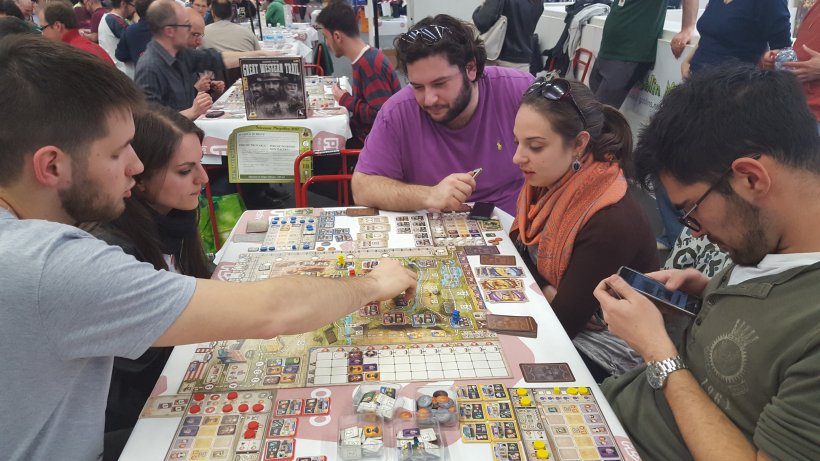
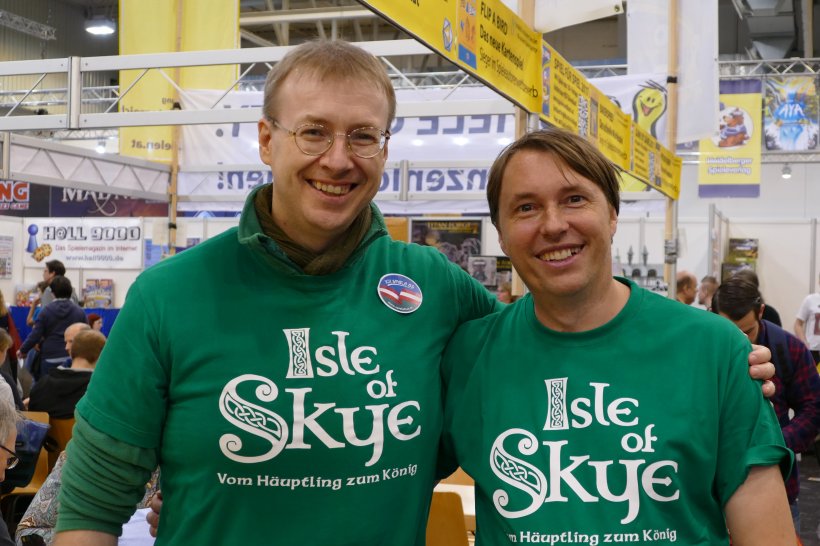

La faccia di Kenparker in copertina è impagabile :D
Avrei detto ripugnante... ma sono gusti...
Quiz: chi riconosco/conosce la tipa rossa al tavolo? Svelo solo che è straniera!
grande gioco!
ho imbustato tutto per velocizzare il setup, la prima volta ci ho messo più di 20 minuti! adesso sto cercando di fare un nuovo record, mi assesto sui 10 min.
m@
Ottima intervista, però avete mancato di nuovo la foto dell'intervistato! :D
Ottima intervista, però avete mancato di nuovo la foto dell'intervistato! :D
done ;)
Per scrivere un commento devi avere un account. Clicca qui per iscriverti o accedere al sito
Accedi al sito per commentare© 2004 - 2023 Associazione Culturale - "TdG" La Tana dei Goblin
C.F./P.IVA: 12082231007 - P.le Clodio 8, 00195 Roma
Regolamento del sito | Archivio | Informativa privacy e cookie | Contatti
La Tana dei Goblin protegge e condivide i contenuti del sito in base alla seguente licenza Creative Commons: Attribuzione - Non Commerciale - Condividi allo stesso modo, v.4.0. Leggi il testo sintetico, oppure il testo legale della licenza.